Samuel Kirk and Son


Samuel Kirk and Son

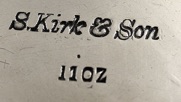

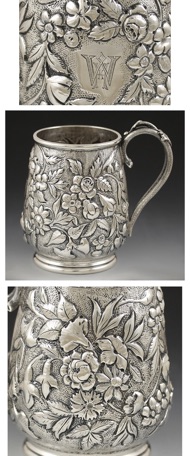
Click on image above to view the 1965 publication
The House of Kirk
Feb. 5, 1919 article on S. Kirk & Son

From the Maryland Historical Society
In 1861 Samuel Kirk’s sons joined him and their brother in the business. In 1868 the two younger brothers left the firm. This partial receipt shows the name of one brother marked out and the second S in Sons struck out. Since this is only a section of the receipt one must imagine that the other brothers name, missing here was struck out too.
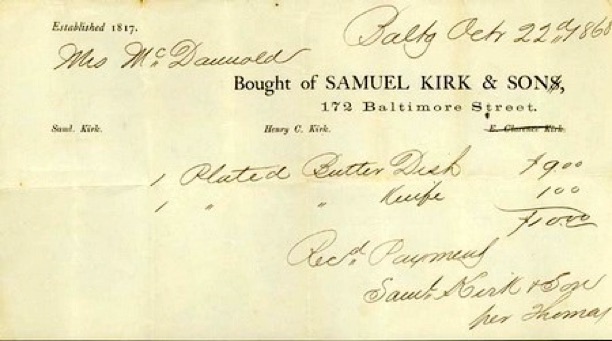
The Established 1817 date is wrong here... the firm was actually formed in 1815. The error was discovered in the early twentieth century when someone took the time to read S. Kirk’s early ledgers.
This transcript is from the Maryland Historical Society, Library of Maryland History.
Samuel Kirk & Son, Inc. Papers, 1834-1979
Maryland Historical Society
Contact Information:
Manuscripts Department
Maryland Historical Society Library
201 West Monument Street
Baltimore MD 21201-4674
410.685.3750
Fax: 410.385.2105
library@mdhs.org
www.mdhs.org
NOTE: I have inserted material into this record. That material is in black italics
Introduction
Baltimore's prominent silver manufacturing company, Samuel Kirk & Son, dates its beginning to 1815 when Philadelphia-trained Samuel Kirk finished his apprenticeship under James Howell and moved to Baltimore. Attracted by the prosperous port, Kirk opened his shop at 212 Market Street (later known as 106 Baltimore Street) with fellow silversmith, John Smith. After the partnership was dissolved in 1821, Samuel Kirk carried on the business alone until his eldest son, Henry Child Kirk, became a partner in 1846.
During this early period Kirk introduced to America the repousse treatment for silverware. Repoussé means formed in relief and refers to a pattern which is beaten or pressed up from the reverse side. Kirk's technique was probably inspired by East India silversmiths, but his patterns were uniquely his own. Eventually he applied this technique to flatware as well as other pieces.
The company prospered greatly. In 1820 Maria Hester Monroe, daughter of President James Monroe, was married in the White House. She chose Kirk Mayflower as her silverware pattern. During his 1824 tour of the United States, General Lafayette ordered a pair of goblets for his Baltimore host, David Williamson. Many of Maryland's prominent families, such as the Carrolls, the Ellicotts and the Ridgelys, were among Kirk's customers.
Samuel Kirk’s son, Henry Child Kirk (1826-1914)started his apprenticeship with his father in 1842 and became a partner in the firm in 1846 at the age of 20. The flatware pattern REPOUSSÉ was introduced in this year as was the pattern MAYFLOWER.
In 1861 and 1863, respectively, two more sons, Charles Douglas Kirk (1840-1880) and Edwin Clarence Kirk (1841-1876), were admitted as partners, changing the firm's name to Samuel Kirk & Sons. The Civil War and its aftermath created an economic slump in the silver business causing Charles and Edwin to become discouraged. When they withdrew from the partnership, the firm reverted to the name Samuel Kirk & Son.
Samuel Kirk died in 1872 (in a house fire) leaving the business to Henry Child Kirk. The firm's technology advanced as hand-wrought repoussé methods were replaced by the use of cylindrical steel rolls and eventually flat steel dies. The repoussé patterns were cut in reverse in a steel die, then stamped on the softer silver with a heavy drop hammer.
Following family tradition, Kirk's son, Henry Child Kirk, Jr., was admitted as a partner in 1890. Six years later (1896) the firm was incorporated with Henry Child Kirk, Sr., as president, William Higgins Conkling (Kirk's son-in-law) as vice-president, James F. H. Maginn as secretary and Frederick W. Kakel as treasurer.
Business continued to prosper as the firm's clientele spread beyond Maryland. Customers included the Belmonts, Astors and Roosevelts of New York; the Lowells, Peabodys and Adamses from Boston; the Biddles, Cadwalladers and Ingersolls from Philadelphia; and the Hamptons, Lees and Davises from the South.
The company suffered severe blows in 1903 and 1904 from two separate fires. At 9:30 AM on June 30, 1903 a fire ignited when gasoline leaking from a tank in the cellar came into contact with the furnace. Much stock and equipment in the workshop were lost but, fortunately, most of the business records and designs were saved.
The firm had barely recovered when the great Baltimore fire of 1904 struck on February 7. Again, vital records and patterns were saved by a quick arrangement between Henry Child Kirk, Jr. and the express company manager across the street. They used express wagons and Kirk employees to save the records of both businesses.
Samuel Kirk & Son moved into temporary quarters at 309 N. Charles St. until a new building could be completed on the site of the one destroyed. The factory began operating again in May 1904 at Guilford and Girard Aves., then moved to the Baltimore St. building in June 1905. The retail store re-opened there in November.
The beginning of the twentieth century witnessed several changes in the company. In the nineteenth century business had been generated primarily by word of mouth as the founder felt that advertising was associated with commercialism. Placing the company into more modern times at their November 1911 meeting, the Board of Directors authorized spending $1,000 for advertising in the Baltimore newspapers. An additional $1,000 was approved for advertising in September 1912. Samuel Kirk & Son's first retail silverware catalog was produced in 1914 and their first national advertisements appeared in the October 1937 issues of House Beautiful and House and Garden.
In 1911 the company directors began discussing the concept of selling their goods at wholesale prices to authorized dealers, but it was not until 1915 that this method of national distribution began. Another innovation was the purchase in October 1913 of the firm's first automobile delivery wagon.
Henry Child Kirk, Sr. died in 1914 and left a deed of trust placing the business in the hands of five trustees. At the termination of the trust agreement in 1924, the company was reorganized as Samuel Kirk & Son, Incorporated with Henry Child Kirk, Jr. as president and treasurer, James F. H. Maginn as vice-president and assistant treasurer, William Higgins Conkling, Jr. (great-grandson of Samuel Kirk) as secretary, and Roderick Douglas Donaldson (grandson-in-law of Samuel Kirk), Martin Laurence Millspaugh (great-grandson of Samuel Kirk), and Charles Markell as directors. Robert E. Coughlan was elected a member of the board soon after.
In addition, the Kirk Realty Corporation was created in 1923 to manage the real estate concerns of the company. A lease was signed with Mano Swartz in October of that year for the four-story building under construction at Charles and Franklin Streets. Swartz agreed to make changes in the building (at Kirk's expense) to accommodate the new tenant's retail operations. At the same time, construction commenced on a new facility at Twenty-Fifth St. and Taylor St. (now Kirk Ave.) for the purpose of handling the wholesale and manufacturing divisions.
The Great Depression of the 1930's had its effect on all businesses including Samuel Kirk & Son, Inc. In spite of the poor economy, the number of agents selling Kirk silver continued to increase and several improvements were made to the factory. Kirk stock generally continued to pay quarterly dividends.
During World War II, Samuel Kirk & Son, Inc. became very involved with the war effort. The War Production Board closely regulated what and how much could be manufactured. Wages and work weeks were controlled. Silver bullion and other raw materials were rationed. In February 1942 Kirk received its first war contract from Liberty Motors and Engineering Corp. Other contracts followed with many companies including American Hammered Piston Ring, Standard Gas Equipment, and Western Electric for manufacturing surgical instruments, metal hardware or performing services such as silver soldering. Production and price controls remained in effect past World War II until the Korean conflict ended in 1953.
The prosperous post-war 1950's saw a shift of population to the suburbs and the rise of shopping centers. Following this trend, Samuel Kirk & Son, Inc. opened a branch store in Edmondson Village on June 2, 1953. A second branch opened in Towson, Md. on May 6, 1958. By the early 1960's, however, the retail division was lagging behind the wholesale operation. Kirk closed their three retail stores in January 1963, having arranged to lease retail space in three Stewart & Co. stores: downtown, York Road, and Reisterstown Road. The retail division of Kirk closed completely in 1975. The leases were allowed to expire at the Stewart & Co. outlets and the department store absorbed Kirk's retail functions into their own operations.
Late in 1966, S. Kirk Millspaugh, great-great-grandson of the founder, gained a controlling interest in the company by purchasing 80% of the outstanding shares of stock. The Kirk Corporation, as it became known, acted as a holding company which owned several subsidiaries including the original Samuel Kirk & Son, Inc. It began to diversify its interests by acquiring the Coastal Trailer Corporation in the late 1960's and Studebaker Southern, Inc., a Florida-based manufacturer of mobile homes,in 1969.
It was hoped that these companies would provide greater financial opportunities and help maintain overall financial stability during periods of fluctuating economic conditions. However, the anticipated advantages failed to materialize. There was little technical or management crossover between companies which resulted in differences in policies and objectives. A construction slump in 1974-1975 compounded the problem. Studebaker Southern, Inc. was terminated in 1972 and Coastal Trailer Corp. was sold off to its original owners in a 1975-1976 reorganization of the parent company.
Other acquisitions by the Kirk Corp. were more successful due to the similarity of their products: Eisenberg-Lozano, Inc. (an importer of silver plate, stainless and pewter holloware) in 1970 and A. L. Hanle, Inc. (a manufacturer of pewter holloware) in 1971. The name of the latter was changed to Kirk Pewter, Inc. in 1972 and Eisenberg-Lozano became Kirk International, Inc. in 1973. The Kirk Collection was established in 1972 for the production of limited edition collector's pieces. The following year it ceased to be a subsidiary and became a trade style of Samuel Kirk & Son, Inc.
In 1968 the Samuel Kirk Museum, Inc. was founded to display Kirk artifacts and develop educational programs on the silver, gold and pewter crafts. The collection was exhibited at the Peale Museum when in Baltimore, but was frequently on tour to art museums throughout the world.
By 1979 the Kirk Corporation found itself in difficult circumstances. The reorganization of 1976 had cost the company a $600,000 commercial loan which increased the company's interest charges and decreased the capital base available for current operations or expansions. The cost of the company's essential raw materials, silver and tin, began to skyrocket and the wildly speculative silver commodity market made it almost impossible to price Kirk's products to meet dealer orders. In addition, the company's manufacturing and office facilities had become severely cramped and a great deal of machinery and equipment needed to be replaced. The high cost of real estate, construction and machinery coupled with the company's reduced financial resources brought the matter to a head.
The Stieff Company, a Baltimore silver and pewter manufacturer since 1892, offered to purchase the assets of the Kirk Corporation. The two companies drew up a proposal which combined management personnel and allowed for the continued production of the Kirk line. The shareholders approved the merger on 10 October 1979 and a new company was born under the name of The Kirk Stieff Company.
A few examples of early S. Kirk history
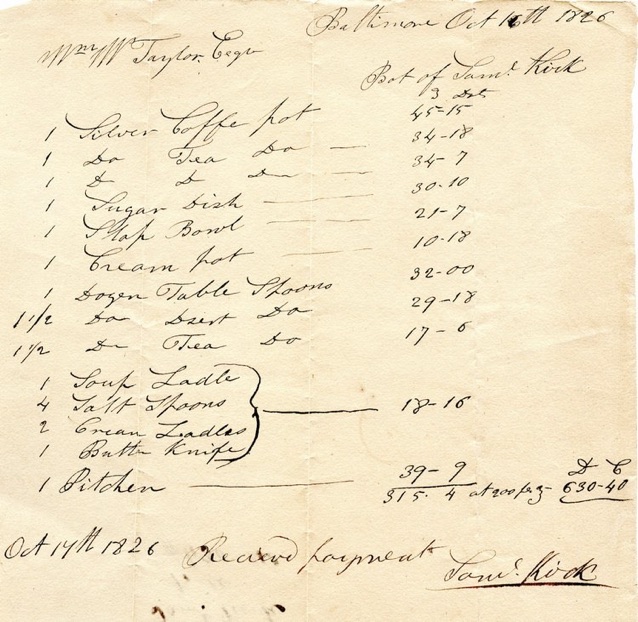
October 14th 1826 Receipt for Mr. William Taylor for the purchase of silver, Signed by Samuel Kirk.


Early TRUE Repoussé work on tongs (approx. 1846)

Fish Server with 1830 Dominical & Assay marks
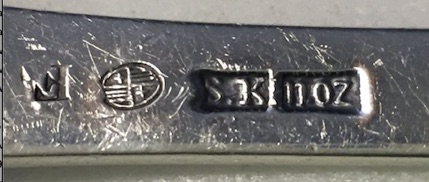
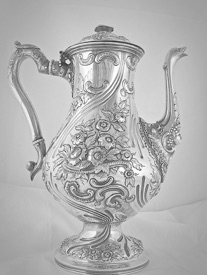
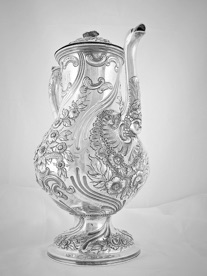
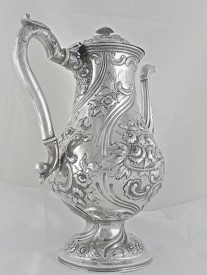
1830’s example of S. Kirk Repoussé Holloware
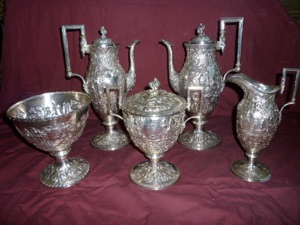
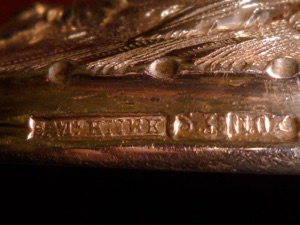
Saml.KIRK 1840’s
A “Who’s Who in the Kirk family involved with the silversmithing industry.
Parts with bold lettering have been added by this author.
Biographical Sketches
SAMUEL KIRK
Samuel Kirk was born on 15 February 1793 in Doylestown, Pennsylvania, the fifth child of Joseph Kirk, a carpenter, and Grace (Child) Kirk. He was educated at a Friends' school until the age of 17 when he was apprenticed to James Howell, a Philadelphia silversmith. In 1815 Kirk completed his apprenticeship and, declining an offer to join Howell's firm, he moved to Baltimore. In this growing port city Kirk established his shop on Market (now Baltimore) St. and took John Smith as a partner. Early products include spoons, tea urns and pitchers.
Kirk married Albina Powell (1796-1865) on 18 March 1817. She was the daughter of Joshua and Margaret (Carpenter) Powell. They had eleven children, three of whom joined their father in the silver business. Only one son, Henry Child Kirk, remained in the firm.
The partnership with Smith was dissolved in 1821 but Kirk continued alone, creating high quality products and attracting such clients as Lafayette and the Bonapartes. About 1825 Kirk introduced the repoussé style in his silverware and initiated repoussé flatware in 1846. This technique was to become synonymous with the Kirk name in the future.
Samuel Kirk died on 5 July 1872 in a house fire. Henry Child Kirk, who had been made a partner in 1846, continued the business in his father's place.
HENRY CHILD KIRK, SR.
Born on 9 February 1826, Henry Child Kirk, Sr. was the sixth child of Samuel and Albina (Powell) Kirk. At age sixteen, Henry began to train as a silversmith in his father's shop. He not only developed his craftsmanship, but also served as bookkeeper, salesman and buyer, traveling to New York and other cities.
In 1846 he became a full partner with his father, changing the name of the company to Samuel Kirk & Son. He took over the business after his father's death in 1872.
During Henry Child Kirk, Sr.'s association with the firm, the volume of business greatly increased, along with improvements in methods of production and the use of machinery. In 1890 Kirk's son, Henry Child Kirk, Jr., was admitted as a partner. The complexity of the firm's activities led to its incorporation in 1896 with Kirk, Sr. as President.
Henry Child Kirk, Sr., was a prolific traveler. He took his first of many trips to Europe in 1856 and journeyed throughout the United States, including the far West. When in Baltimore, he was active in civic and church affairs. For more than fifty years he was Treasurer of the Franklin Street Presbyterian Church.
Henry Child Kirk, Sr. was married three times. His wives were Virginia Elizabeth Kent Hardesty (d. 1855), Lucy Ann Strother Buckner (d. 1876), and Elizabeth Hemsworth Hollins (d. 1900). He had five children, of whom his son, Henry Child Kirk, Jr., carried on the family business after the death of his father on August 1st 1914.
HENRY CHILD KIRK, JR.
The fourth child and only son of HCK, Sr., Henry Child Kirk, Jr. was born on 16 December 1868. Following family tradition he joined his father in the silver business in 1890. It was Henry Child Kirk, Jr. who was instrumental in saving the company records and design patterns from the Baltimore fire of 1904.
At the death of Henry Child Kirk, Sr. in 1914, a trust agreement went into effect regarding the management of the company. In 1924 the terms of the trust had been fulfilled and it was terminated by a unanimous decision. Henry Child Kirk, Jr. became the company's President and Treasurer.
Kirk, Jr. led the company into the twentieth century. The retail shop moved into new quarters on Charles Street and the manufacturing division relocated to the corner of what is now Kirk Ave. and Twenty-fifth Street. Deviating from the policy of the company's founder, Kirk, Jr. advocated newspaper advertising to promote the business. A network of agents was established to sell Kirk products nationwide.
Henry Kirk, Jr. married Edith Huntemuller in 1891 and had three daughters. He died on 28 February 1932 leaving the business to his nephew, Martin Laurence Millspaugh.
MARTIN LAURENCE MILLSPAUGH
M. L. Millspaugh was the first president of Samuel Kirk and Son, Inc. who was not specifically trained as a silversmith. He was born on 8 March 1884 on a cattle ranch in Kansas, the middle child of Alice Virginia Kirk Millspaugh and nephew of Henry Child Kirk, Jr. He was educated at the University of Illinois as a mechanical engineer and spent the early part of his career working for a Canadian steel company.
After serving in World War I, Millspaugh became a consulting engineer in Chicago, then joined an architectural firm. He entered the investment and banking business with his brother-in-law which served him well when he was elected to the Board of Directors of Samuel Kirk & Son, Inc. in 1924.
At the death of his uncle in 1932, Millspaugh was elected President of the Kirk Company, and later became Chairman of the Board. He guided the company through the World War II years, when raw materials and production were tightly controlled, and was instrumental in the expansion of the company's retail outlets in the 1950's.
M. L. Millspaugh married Elisabeth Park in 1921 and had three children. At his death on 7 March 1964, his son, Samuel Kirk Millspaugh, took his place in the family business.
SAMUEL KIRK MILLSPAUGH
Born on 27 July 1930, Samuel Kirk Millspaugh, began working at the family firm at age 13. He was first elected to the Board of Directors in 1959 when he was also named Vice-President of Advertising and Public Relations. The following year he was designated Vice-President of Sales and Advertising.
In 1966, two years after his father had died, S.K. Millspaugh bought a controlling interest (80%) in the company. A period of reorganization took place which resulted in changing the family business to a public corporation by 1969. S. K. Millspaugh directed the acquisition of several subsidiary companies during the early 1970's. He became Chairman of the Board and Chief Executive Officer in 1972. He was still head of the company when it merged with the Stieff Company in 1979.
S.K. Millspaugh married Mary Josephine Bentley Offutt in 1955. They had two daughters and a son.
Please note: This is just a part of the huge file held by The Maryland Historical society. The balance of the on-line info can be found at:
www.mdhs.org/library/Mss/ms002720.html
Please visit and support the Maryland Historical Society.
October 1937 and April 1937 Kirk pamphlets
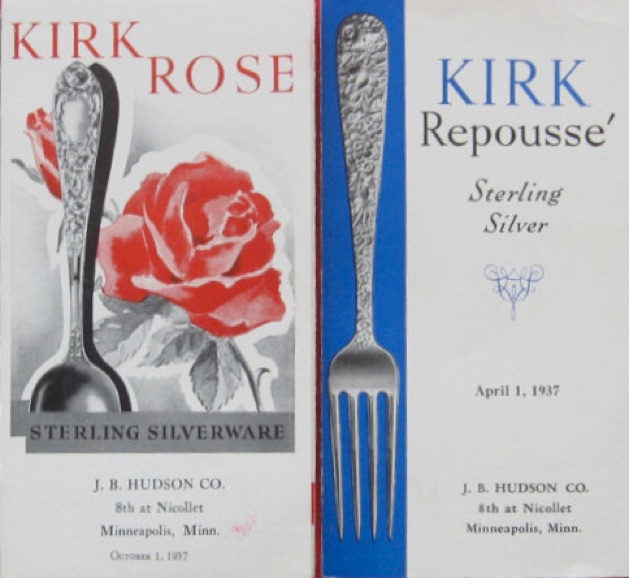
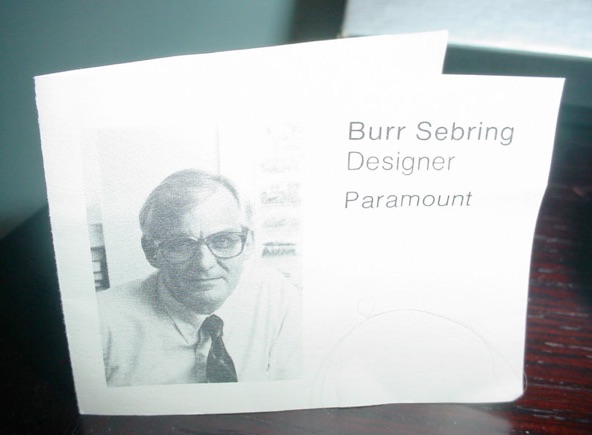

This is the Kirk & Son Co. mark used 1896-1924, from a Tomato Server handle shown below
The STERLING mark means this piece is from 1914-1924

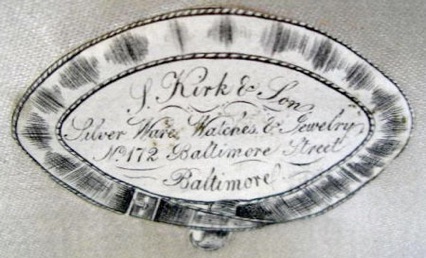
From an 1872 silver chest
The 1914 S. Kirk & Son Catalog
Click on the catalog to view
1963 Kirk Hollow Ware catalog and price list
Click on image to go to the catalog
I have a LOT more KIRK info but time has not allowed me to post it as of yet. If you have particular questions, please email me at scottinelmgrove@yahoo.com
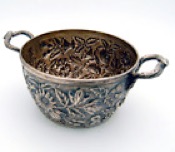
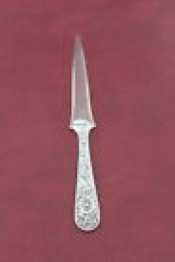
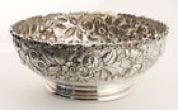
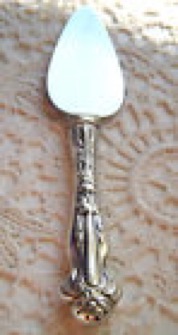
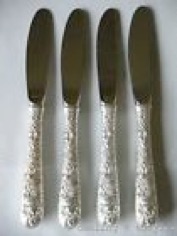
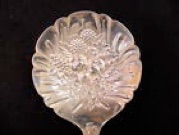
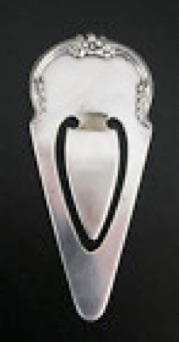
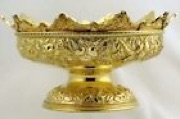
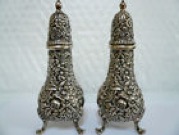
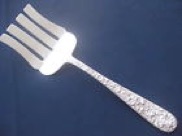
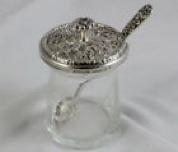
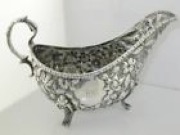
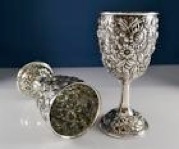
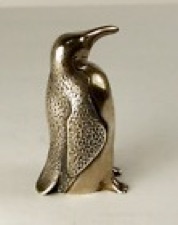
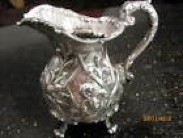
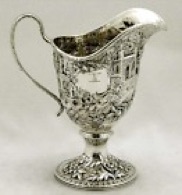
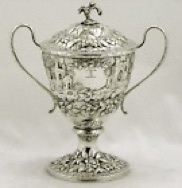



Circa 1846 tongs, with true Repoussé of grapes vines and leaves, with hand chasing,
S.Kirk & Son, Coin Silver. You can see where the pattern was beat up from the back and not smooth as most “Repoussé” is, but those are not true Repoussé. (From my personal collection)
S. Kirk & Son was an independent company from 1815 to 1979 and products from that period should be referred to as KIRK and not Kirk Stieff.
In 1979, “America’s Oldest Silversmith” S. Kirk & Son was acquired by The Stieff Company and was renamed The Kirk Stieff Company. Operations at the old Kirk Avenue factory were quickly moved into the more modern Stieff factory in the Hamden section of Baltimore.
Below I have reproduced the 1914 book
“The Story of the House of Kirk”
Click on book to read the 1815-1914 history of Kirk
The book has photos of the KIRK hallmarks from the earliest days through 1914. When examining the marks, look close as there are subtle differences in them that give the clues as to the date of a piece. The slightly different slope of the “&” in S. Kirk & Son is one the small clues.
For those of you who have come here looking for dating information... S. Kirk & Son did not use a dating system like that of Stieff where you can easily determine the year a piece of hollow ware was made. The name changes over the years tell a lot of the story as well as assay marks in the early 19th century. The back pages of “The Story of the House of Kirk” give the hallmarks though 1914. Notes below give highlights of other clues to dating. Also, farther down are pages from 1967 with Kirk’s history of hallmarks and the dates uses.
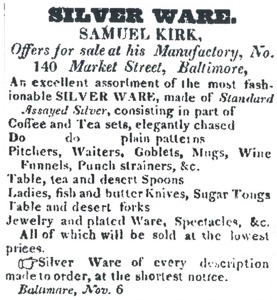
November 6th 1830 Kirk Advertisement
(One wonders if anyone proof read this)
A FEW “HEADS UPS” FOR YOU DEALERS AND EBAY TYPES LOOKING FOR A QUICK ANSWER ON DATES AND WHO WILL NOT READ THE WHOLE DOCUMENT... read this next section carefully.
PLEASE keep in mind that the hallmark S. Kirk & Son was used
THREE times and should not be automatically considered to be an early
mark. The mark was used 1846 to 1861, 1868 to 1896 and
again from 1932-1999
The hallmark “S. Kirk & Sons” (plural) is ONLY from 1861-1868
(TWO SONS JOINED THE FIRM IN 1861 & 1863 AND WERE GONE IN 1868)
Pieces marked 10.15 or 11 OZ are not sterling silver, but COIN silver
Kirk FIRST used the word STERLING in 1914... so any silver with that word is going to be 1914 or later. The use of the “S. KIRK & SON” hallmark and STERLING is going to be 1932 or later... NOT 1868-1896
Unlike other Baltimore silversmiths that starting making 925/1000 silver in 1861 when the big Nevada silver strike of 1859 starting reaching the east coast... Kirk held out making only COIN silver until 1886. Also know that KIRK made COIN SILVER and 925/1000 until 1896 before making the jump to only 925/1000 silver.
THE FLATWARE PATTERN “REPOUSSÉ” WAS INTRODUCED IN 1846.
THE HOLLOWARE PATTERN “REPOUSSÉ” was debuted in 1828.
PLEASE DO NOT CONFUSE THE TWO DATES AS THE PATTERNS ARE NOT THE SAME.
FLAT WARE MARKS
S. Kirk & Son was used 3 times... 1846 to 1861 and
1868 to 1896 and again 1932-1999
The mark S. Kirk & Sons (plural) only applies to 1861-1868
Pieces marked S. Kirk & Son Co or CO are from 1896-1924
The mark S. Kirk & Son Inc. are from 1924-1932
Pieces marked S. Kirk & Son STERLING are 1932-Present*
*Lifetime Sterling is currently selling some patterns and owns the names S. Kirk & Son, Kirk Stieff
Please Note: A popular silver website www.925-1000.com
has inaccurate information as to the KIRK hallmarks and years of use.
There are variances in the hallmarks used at S. Kirk & Son ...PLEASE use the pages just below to see the small changes in the hallmarks to determine the proper date. You can also EMAIL me clear, crisp photos of the hallmark in question and I can ID the date for you at scottinelmgrove@yahoo.com
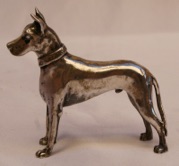
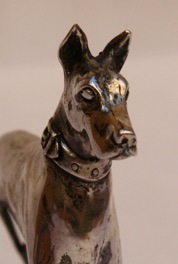
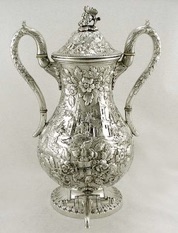
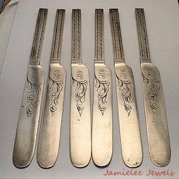
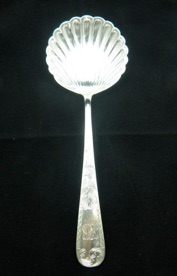


The flatware patterns offered by S. Kirk & Son in 1954
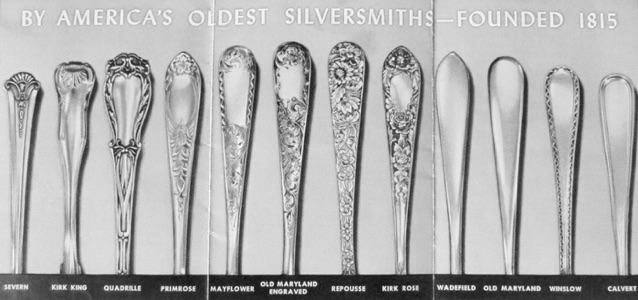
Here is the S. KIRK & SON version of the dates certain marks were used, as published in 1967.
PLEASE NOTE that on the second page, the marks are separated into FLATWARE and HOLLOWARE
The images are reproduced, but the 1967 images were blurred when published.
There are ERRORS and OMISSIONS in these pages.
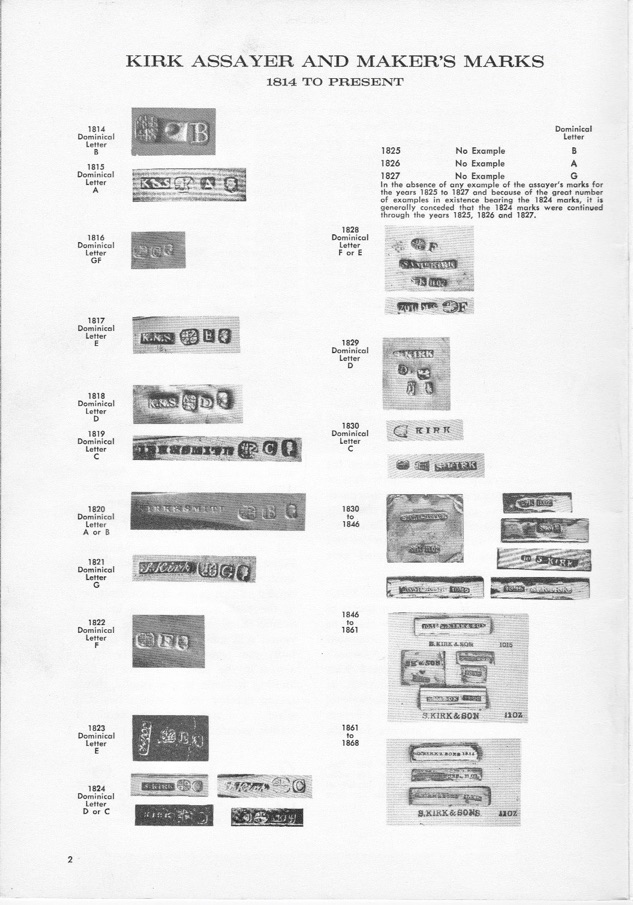
---BELOW---
Several ERRORS here on the left side...
The first date of 1868 to 1896 should read 1868-1890. Concerning the S. Kirk & SON 11 OZ mark...This mark began in 1890 and was used until 1896 when Kirk stopped making Coin Silver and changed the hallmark to include the CO or Co depending on the type of wares. Should read 1890-1896 and not as published.
KIRK first used the word STERLING in 1914, but that does not appear in these pages until 1925. There were overlap years starting in 1914 that had both the STERLING mark as well as the 925/1000 purity mark.
LOOK at the CO and Co marks, middle page, left side. The FLATWARE had the CO (both CAP letters)
while the HOLLOWARE had the Co (small o) mark.
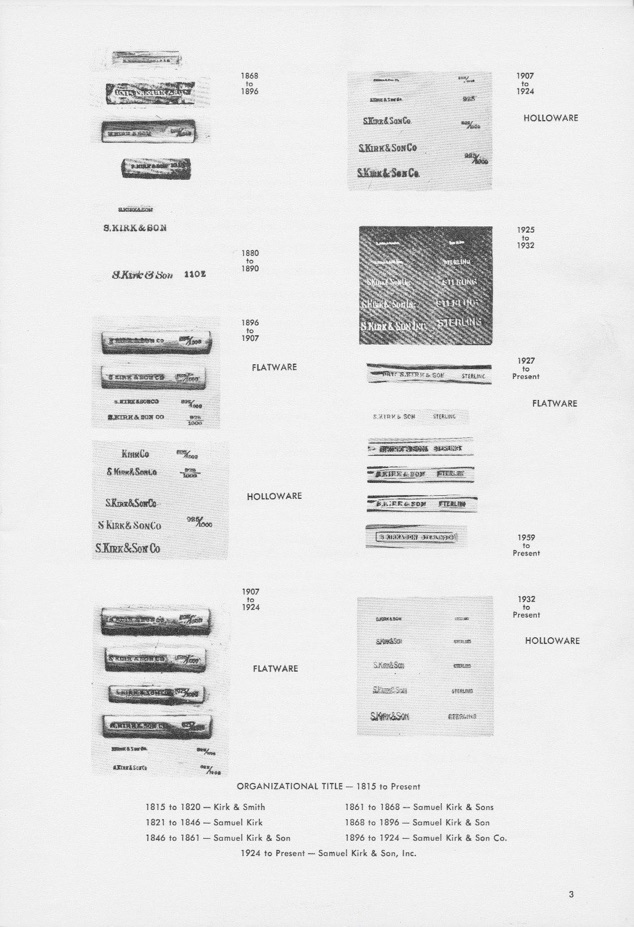
Above... The word PRESENT refers to 1967 when these pages were published.
NOTE: The above ORGANIZATIONAL TITLE is the legal name of the company and NOT the way the hallmark appears on the silver

1883 reverse of a Mayflower fish server, showing hallmark and purity mark
Samuel Kirk & Son
The history of S. Kirk & Son is told farther below by the Maryland Historical Society
There is a lot of confusion concerning the various differences in the pattern of Kirk’s famous Repoussé pattern of 1846, so let me address that right off.
Below are examples of the S. Kirk & Son pattern REPOUSSÉ
Note that the pattern is very different on some of the pieces. When the pattern was first created, it was a hand made pattern in true Repoussé and each piece was different. When Kirk moved on to dies, there seems to be a concerted effort to keep the pattern looking hand made and different dies were used for various pieces to continue that look. Over the years, the pattern changed, different flowers were used as the central flower... sometimes a rose, daisy or a chrysanthemum. The round, cylinder style hollow handles on knives were hand chased on the sides. When the knives became more tapered, the hand chasing was dropped for a smooth sided hollow handle. In the last half of the Twentieth Century, they started using the same patterning on the pieces.
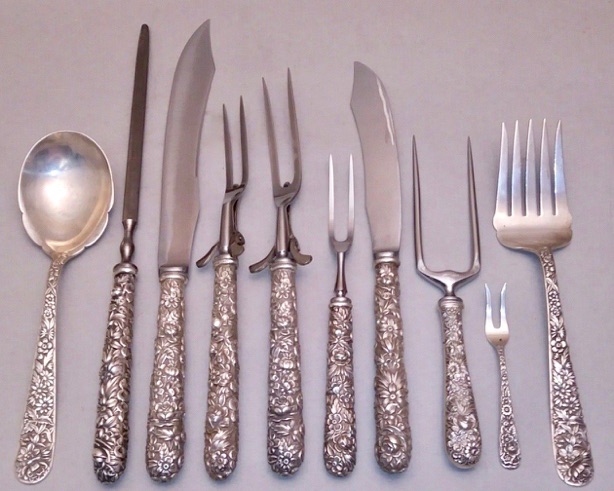
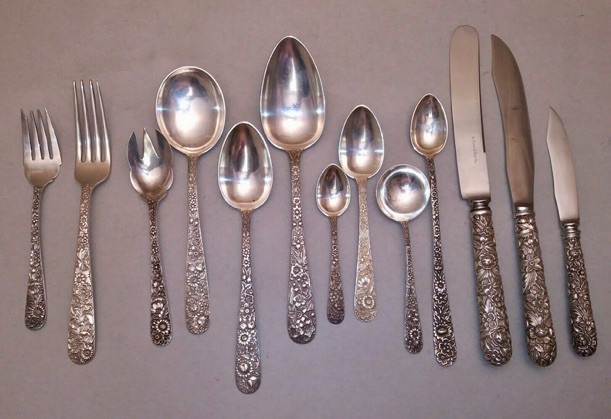
If a piece is marked S. Kirk & Son and is completely covered in flowers... it is the Repoussé pattern. Note... the 1937 KIRK pattern Kirk ROSE has a place for a monogram. It is shown at the top of the page, next to Repoussé.
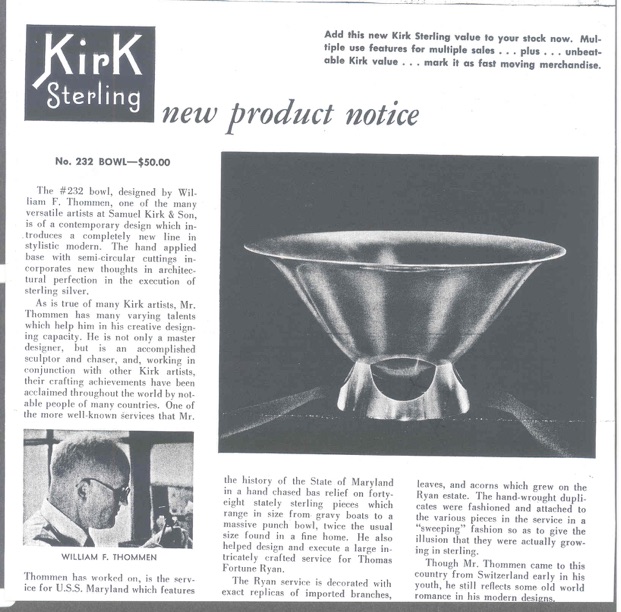
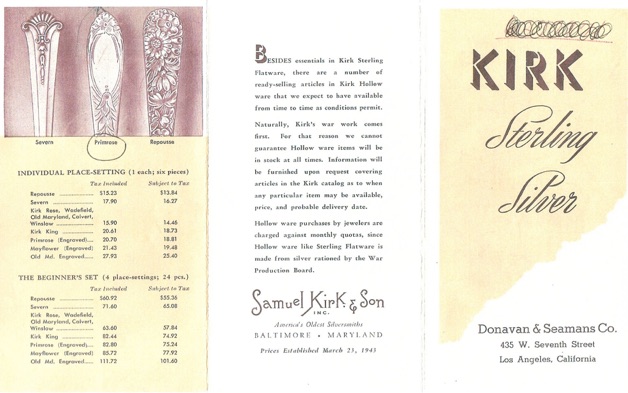
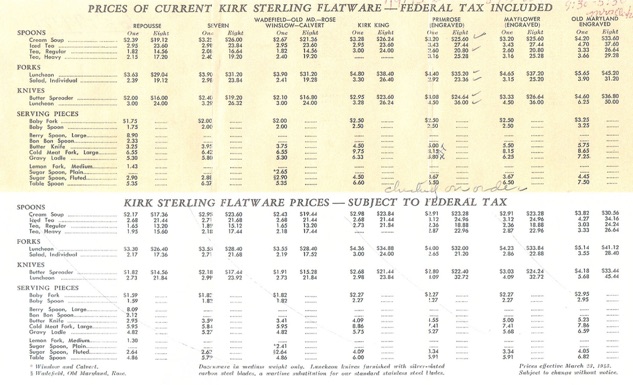
The hard to read bottom line middle reflects the shortage of stainless steel during WWII.
Kirk had to dig back into old stock of carbon steel blades from the early 1920s to make luncheon knives. I am surprised these old steel blades did not go to a war time scrap drive instead.

